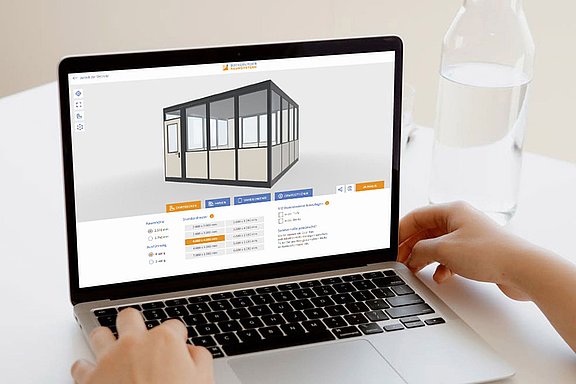Configurator for the distribution of variant-rich products
Author: Matthias Baumgartner
"Buying a car without a configurator? What has become essential in the automotive industry is also increasingly being utilized in many other sectors to successfully market variant-rich products. The reasons why manufacturers offer variants of their products can be diverse, such as:"
- Increasing product variety (addressing new target groups and markets)
- Satisfying new and constantly changing requirements
- Considering technological advancements
- New legal regulations
- Competitive situation – securing own market positions
- Customer needs (e.g., need for variety – facelift)
- Ensuring 'demand-oriented' products."
If a product has various distinct features, the number of product variants available in the market automatically increases. These differences can be both functional (model, features, size, options) and visual (colors, materials, shapes,...).
By combining features, the number of possible product variants can quickly escalate to several hundred, thousand, or even millions.
The challenges with variant-rich products
In order to successfully sell this high number of product variants, the following central challenges must be overcome:
- Overwhelming for customers – they lose track due to too many options. (read the blog article: Increase sales with variety.)
- Complex variant management – the more complexity, the more intricate the management of variants becomes.
- Challenges in sales:
- Sales representatives need in-depth product knowledge and must always be provided with the most up-to-date information.
- The selection of exclusively valid combinations is often tedious and time-consuming, and in the end, it is still often erroneous.
- Complex price calculation and quotation preparation.
- Presentation and representation of all possible variants.
- Tailored strategy to market the right variants to the right target audience.
An adequate and proven tool to manage the complexity and overcome these challenges is a configurator.

Calculate project scope
Results in just a few clicks.

Efficient sales of product variants
In the sales of customizable or modular products (furniture systems, outdoor kitchens, etc.), product configurators are playing an increasingly important role.
Benefiting not only the sales department but also the entire company, the right use of a configurator can make a significant difference. Whether you are looking for 3D product presentations with Augmented Reality, need an effective marketing tool for lead generation, or desire a tool for bill of materials and drawing creation for manufacturing - configurators offer versatile solutions to extract maximum value from your requirements.
A product configurator not only consistently provides valid configuration options but also delivers additional crucial added values for sales:
- Best Match’: Selecting the right products according to the wishes and needs of the customers.
- Support through Guided Selling: Quickly and easily finding the right product, the suitable system.
- Product presentation in 2D, 3D, or even with Augmented Reality functionality.
- Due to the personalized experience for the customer, a configurator is also highly successful as a lead generator.
- Generation of bill of materials, drawings, quotes, PDF documents, calculations, etc.
- Real-time pricing calculation including consideration of customer-specific discounts or currencies.
- Data exchange with other systems (PIM, ERP, CRM, etc.). Both system inputs and outputs can simplify and expedite sales processes.
- Knowledge database for (new) sales representatives.
- ...

Requirements for a configurator for variant-rich products.
Maintenance of item master data.
In the digitalization of processes, managing item master data is essential. Therefore, it is imperative to prepare them meticulously (uniform writing style, product descriptions, languages, prices, images, data sheets, etc.). One option for this is using an ERP or PIM system, but Excel is also frequently employed for data management.
Rule set
Besides the item master data itself, depicting the rule set and dependencies are crucial for a well-functioning configurator. Sometimes, this knowledge is distributed among specific employees in a company and needs to be documented first. In this context, a configurator is the preferred solution to preserve and ensure this vital knowledge without relying on personnel changes within the company.
Often, it's also a combination of existing Excel sheets that can be used as a basis for depicting the rule set in the configurator. If the logic is already mapped in an ERP or PIM system, it can also be used for integration into a web-based configurator.
Presentation of products and provision of information.
Especially when using the configurator on the company website, it functions like an advisor. It assists in presenting the product in all its variants optimally and promptly answers customers' questions. Often, it is necessary to combine the configuration itself with real-time visualization. It's not helpful if the user can select a different color (e.g., red instead of blue) but only sees a blue product.
By providing your customers with all the necessary information and answering their initial questions using the product configurator, you increase the likelihood that they are willing to get in touch with your company and take the next step.
If you opt for 3D visualization, the necessary data for creating a web-based real-time 3D representation must be provided (CAD data, images of all configurations, drawings, etc.).
In a two-dimensional representation, a 3D viewer is not required, but a large amount of photographic material is often needed to depict all variants. Many quickly reach their limits in this regard. That's why at Combeenation, 80% of the configurators are already implemented in 3D.

Guide to Creating a Product Configurator for Variant-Rich Products.
At the beginning, it is crucial for the company to clearly define the objectives of the configurator. Having clear objectives from the outset significantly contributes to the success of a configurator project. Below are some outstanding examples of goals in configurator projects:
- Increasing revenue
- Gaining market share
- Improving sales efficiency
- Establishing a direct-to-consumer sales channel (D2C)
- Reducing order errors Minimizing customer inquiries ('Can I combine feature A with feature B?', 'Please provide the price for the variant with...')
- Showcasing product variety and details
- Simplifying product presentation
In the initial phase of conceptualization, it is essential to thoroughly examine the product itself. Without a comprehensive technical product definition (product structure, features & variations, rules and dependencies, accessories & options), implementing the configurator becomes challenging.
If there are no existing data sources, this knowledge needs to be documented in writing. Furthermore, it's necessary to define what calculations the configurator should perform (prices, dimensions, weight, compatible mounting materials, etc.).
Don't forget to consider who the users of the configurator are, how they will use it, and what they want to achieve with it. This task often helps in identifying the functionalities the configurator needs to cover at an early stage.
From this, you can also determine the system inputs (How will the data enter the configurator?) as well as the system outputs (What data in which formats do I want to receive where?). A good configurator is one that is user-friendly. For this, the following considerations should be made:
- Where will the configurator be accessible (e.g., on a specific landing page for anonymous users, on a dealer portal for distributors, etc.)?
- Which devices should the configurator be compatible with (smartphone, tablet, desktop)?
- What design should the configurator be adapted to (aligned with the website, aligned with corporate design)?
- Should the configurator be available in a different design for partners (white labeling)? Internationalization (multiple languages and currencies)?
And of course, the visualization of products plays an important role depending on the use case. Based on existing data such as photos, CAD files, and drawings, 3D models can be created. The decision whether the product representation should be in 2D or 3D should be made very early, as both types have their advantages and disadvantages. More about this in the blog article: "2D Configurator vs. 3D Configurator".
We have found that a solid concept is the fundamental requirement for a successful configurator. Therefore, we assist our clients from the very beginning with an initial custom design concept even before the actual implementation, allowing them to 'test' the potential end product and gain an initial impression.
We would be delighted to impress you with a tailor-made configurator concept. Please feel free to contact us for a non-binding initial discussion.
FAQ
Was sind variantenreiche Produkte
Variantenreiche Produkte sind Produkte, die in unterschiedlichen Ausführungen oder Versionen erhältlich sind, um den verschiedenen Bedürfnissen und Präferenzen der Kunden gerecht zu werden. Diese Produkte können in verschiedenen Farben, Größen, Geschmacksrichtungen, Funktionen oder Designs angeboten werden. Ein klassisches Beispiel für variantenreiche Produkte sind Smartphones, die in verschiedenen Modellen mit unterschiedlichen Spezifikationen und Funktionen erhältlich sind. Solche Varianten ermöglichen es den Kunden, ein Produkt auszuwählen, das genau ihren Anforderungen entspricht, und bieten gleichzeitig dem Unternehmen die Möglichkeit, sein Angebot breiter aufzustellen und verschiedene Zielgruppen anzusprechen. Variantenreiche Produkte bieten somit eine erhöhte Flexibilität und Anpassungsfähigkeit, um den vielfältigen Marktbedürfnissen gerecht zu werden.

Calculate project scope
Results in just a few clicks.



